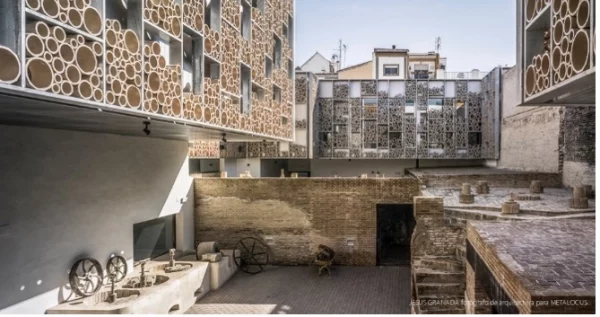Triana is one of the most emblematic neighborhoods of Seville, offering a multitude of plans and stories to discover. According to mythology, Triana was founded by Astarte, the goddess of fertility, when she took refuge on the western bank of the Guadalquivir River while fleeing from Hercules, who had become obsessed with her and relentlessly pursued her. Hercules remained on the opposite bank of the river and gave rise to the city of Hispalis (the Roman name for Seville).
Triana is the birthplace of illustrious figures. It saw the birth of the navigator Rodrigo de Triana, who accompanied Christopher Columbus on his voyage to India and, unexpectedly, became the first to sight the American continent, a moment that changed the course of human history.
Among its courtyards and narrow streets, the Master Juan Belmonte also grew up, revolutionizing the art of bullfighting during the first half of the 20th century, and there is a statue dedicated to him in Plaza del Altozano. Additionally, Triana has been the home of countless flamenco singers and dancers, including Matilde Coral and her husband Rafael, Gracia de Triana, Paco Taranto, Naranjito de Triana, Antonio el Bailarín, and many more.
Triana Bridge
Crossing to the other side of Seville means crossing the Isabel II Bridge, better known as the Triana Bridge. While the Romans discarded the idea of building a fixed bridge, it was the Arabs who created a bridge of boats (a row of boats with wooden planks placed on top for citizens to cross from one bank to the other). It wasn’t until 1852 that the current iron bridge, the oldest in Spain, was inaugurated. Inspired by the now-disappeared Carrousel Bridge in Paris, designed by Polonceau, it, along with its surroundings, provides one of the most characteristic views of Seville.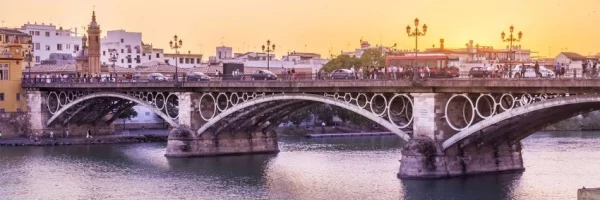
Capillita del Carmen
At the end of the Triana Bridge, next to the Altozano Square, you’ll find the Capillita del Carmen, built in 1928 by the architect Aníbal González and the ceramist Emilio García. It’s a small building, made of exposed brick with a striking reddish color, consisting of the chapel itself and an octagonal bell tower—a place worth stopping to admire.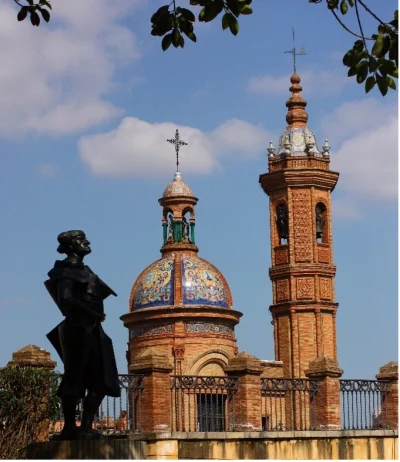
San Jacinto Church
Another monument worth visiting is the San Jacinto Church. It was built in the 17th century on the site previously occupied by the Candelaria hermitage, which collapsed after floods devastated the area. It was made possible thanks to the initiative of the wealthy man Baltasar Brun de Cervera. In the hands of the Dominican order for most of its history, it has served as a school for mathematics, rhetoric, and other sciences; a healing house for the provincial hospital to treat victims of a cholera epidemic; one of the ecclesiastical properties affected by the Mendizábal confiscations and left to abandonment; municipal property and a primary school; the headquarters of various brotherhoods, which have sought refuge within its walls throughout its history.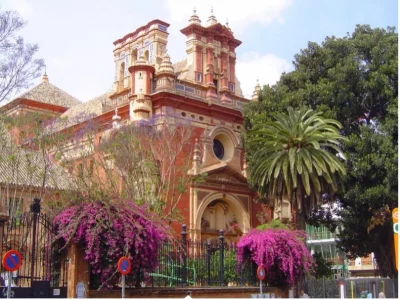
Royal Parish of Señora Santa Ana
Also not to be missed on this list is the Church of Santa Ana, or as it is popularly known, “the Cathedral of Triana,” which was born when King Alfonso X the Wise ordered the construction of a small church next to San Jorge Castle to thank what he considered a miracle: the cure of an eye disease he was suffering from. Construction began in 1266, thanks to the hands of Castilian master stonemasons who accompanied the Christian troops and Muslim craftsmen, experts in the use of brick, the basic building material during the Almohad era. It is the first temple built in Seville after the reconquest of the city in 1248.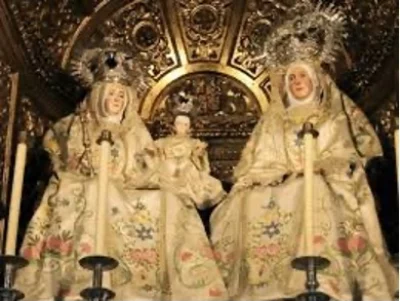
The building of the Royal Parish of Lady Saint Anne, in the Gothic-Mudéjar style,
Nobles, soldiers, merchants, sailors, and wealthy men of the neighborhood built chapels in the original surroundings of the temple starting from the late 15th century. They founded chaplaincies and left their marks alongside those of great sculptors, painters, architects, goldsmiths, and ceramists who executed magnificent works that we can admire today as part of the building or its artistic heritage.
The main altarpiece, a work by Nufro Ortega and Nicolás Jurate, contains 15 panels by Pedro de Campaña, a major exponent of Mannerism in his time. The altarpiece was completely restored by the Andalusian Institute of Historical Heritage between 2008 and 2010.
The earthquake of 1755 caused significant damage to the temple, so Pedro de Silva, the chief master builder of the archdiocese, partially reconstructed it and gave it a Baroque appearance that still remains on its exterior.
A new intervention was carried out on the interior between 1970 and 1972, under the direction of architect Rafael Manzano, to reveal the brick and stone, thus recovering its original medieval appearance.
The tower crowning the church is a clear example of the mix of styles that buildings acquire over the centuries; the lower part is clearly Mudéjar (from the 14th century), while the upper section, erected in the 17th century, is Baroque.
Upon entering the church, the first thing we encounter is the Baroque choir, which houses the Virgin of the Rose, one of Alejo Fernández’s most important works. We continue our visit by heading towards the nave on the epistle side (to our right). The first chapel, known as the Ánimas Chapel, is a small temple adorned with 18th-century Baroque stucco, although its origin dates back to the 16th century. It houses the Virgin of Carmen. Next are the chapels of the Divina Pastora and the Virgin of Victory, between which lies the tomb of Iñigo López, of great interest as the first work in Seville by Niculoso Pisano (16th century), an innovator who introduced a revolutionary technique in Seville that allowed ceramics to be decorated as if they were oil paintings. Next to the door is the 17th-century Chapel of San Joaquín, attributed to Bernardo Simón de Pineda. This chapel provides access to the church’s crypt, which houses the parish museum.
Moving to the head of the church, we find the Calvary Chapel, the Main Chapel, and the Mother of God of the Rosary Chapel. The first one houses the baptismal font and the Christ of Socorro from 1620, attributed to Andrés de Ocampo, and is notable for the mural paintings that adorn the ribbed vault. The Main Chapel houses the impressive Renaissance altarpiece from the early 16th century, in the Plateresque style, highlighted by 15 beautiful paintings created by Pedro Campaña in 1550. It is presided over by the images of Saint Anne (the Virgin’s Mother), the Virgin, and the infant Jesus, a sculptural group from the 12th century, although the child is from the 18th century. The Mother of God of the Rosary Chapel is presided over by a Baroque altarpiece created between 1709 and 1713, which houses the Virgin of the Rosary from 1816.
Before continuing, we turn to admire the choir, whose stalls were made between 1619 and 1620, with a notable organ dating back to 1814. Next, in the epistle nave, we find the 16th-century Sacramental Chapel, with noteworthy decorations including paintings and a 16th-century tile frieze. It houses an altarpiece from 1713 that holds the Brotherhood of the Holy Sacrament. The following chapel is that of San Cristóbal (Christ Bearer), larger in size, covered with 15th-century star-shaped vaults and decorated with a 16th-century tile base, although it has later additions. Opposite it, on the side of the choir, is the 17th-century altarpiece of Santa Justa and Rufina.
Santa Justa and Rufina were two sisters, potters born in Triana in the years 268 and 270 (under Roman rule) who, when a pagan procession passed by asking for alms at their home, not only refused to pay but also broke the sculpture. As a result, they were sentenced to torture and eventually died in prison. The church declared these Sevillian martyrs as saints, and they are attributed with protecting the Giralda so it wouldn’t collapse during the earthquake of 1504, which is why they are always represented holding the tower.
The next chapel is the Baptism Chapel, from the 17th century, also with interesting decorations featuring paintings and a tile base. The last chapel, with a layout similar to the first one we mentioned (the Ánimas Chapel), is dedicated to Saint Francis and is presided over by an interesting Plateresque altarpiece from the 16th century that houses beautiful paintings from the school of Domingo Martínez.
Declared a monument of cultural interest since 1931.
The most notable festivals in this parish include Corpus Christi (Corpus Chico), celebrated with a procession since the 16th century, the novena to Lady Saint Anne from July 18 to 26, the Feast of the Saint, triduums, quinaries, novenas, and processions by the Penitence and Glory brotherhoods of the Triana neighborhood.
Castle of San Jorge
The Castle of San Jorge was born as a defensive fortification during the Visigothic era, a purpose it continued to serve when the city came under Almohad rule. After the Christian reconquest, it became the property of the Military Order of Saint George, the patron saint of soldiers and knights, until later entering its darkest period: it became the headquarters of the Inquisition. During that period, it also served as a prison and inspired the composer Ludwig van Beethoven, who, in his opera ‘Fidelio’ (1805), spoke of a Sevillian prison where, in the late 18th century, prisoners of conscience were confined. Behind its bars, famous figures such as the Florentine artist Pietro Torrigiano, who, according to the writings of the architect and painter Giorgio Vasari, died there, ended up. In the 19th century, the Castle was demolished to create an expansion from Plaza del Altozano to Calle Castilla. A food market was established on the site that is still active, and visiting it is also essential to get to know Seville’s cuisine and way of life. Numerous archaeological remains were found underground, which the City Council did not hesitate to uncover, creating the current center for the interpretation of the ruins and the impact of the Inquisition on the city. You can take advantage of this visit to explore the Alley of the Inquisition, next to the castle itself. It is a narrow passage 35 meters long through which prisoners were led to the prison and to be tried or, if considered guilty and sentenced, to the stake.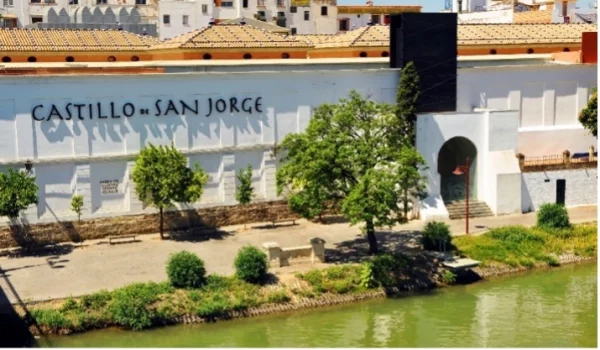
Enjoy Triana ceramics: Triana Ceramic Center
For centuries, Triana had a significant presence of the Romani people, who concentrated in a part of the neighborhood known as “cava” and made a living from crafts, including blacksmithing and pottery. That’s why the neighborhood has the Triana Ceramic Center (CCT), which was established in 2014 with the aim of highlighting the history of its pottery tradition.
It occupies the former headquarters of the company Cerámica Santa Ana-Rodríguez Díaz S.L., a two-story building. On the ground floor, the pottery production process is described, tracing the old spaces of the factory, and it discusses the numerous workshops that were active in the neighborhood in the early 20th century, such as Mensaque, Montalván, or Ramos Rejano. Meanwhile, on the first floor, there is the permanent collection, with works from the 12th to the 20th centuries, a temporary exhibition hall, and a space titled ‘Triana, Heart of Flamenco. Names and Posters of the Biennial,’ which houses a permanent exhibition that reviews the graphic history through its posters since 1980.
Triana Ceramic Center (Callao Street, 16, corner of Antillano Campos Street)
https://icas.sevilla.org/espacios/centro-ceramica
Furthermore, in the area, many workshops still preserve the tradition of crafting ceramic products, which can also be purchased on-site (Calle Antillano Campos and Calle Alfarería). Many of these workshops offer classes for those who want to learn this art and craft (Calle Pureza 72).
